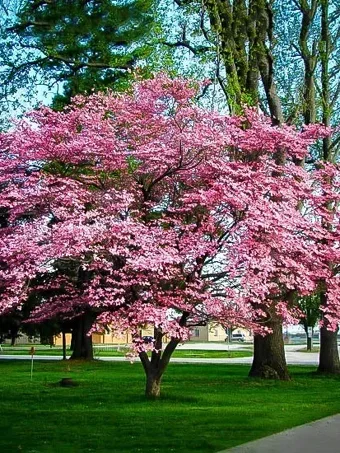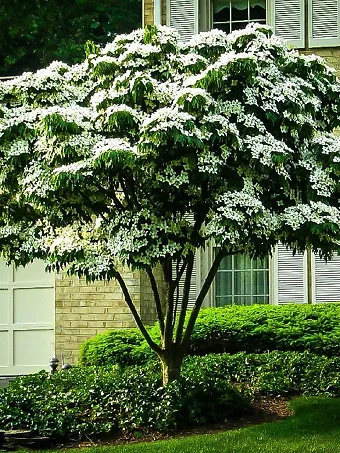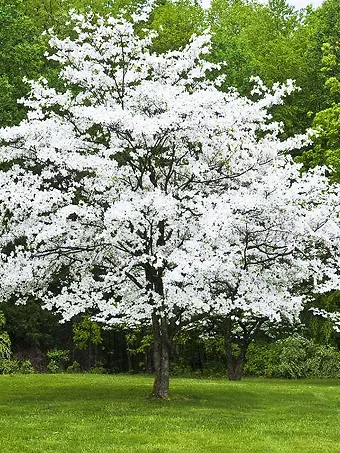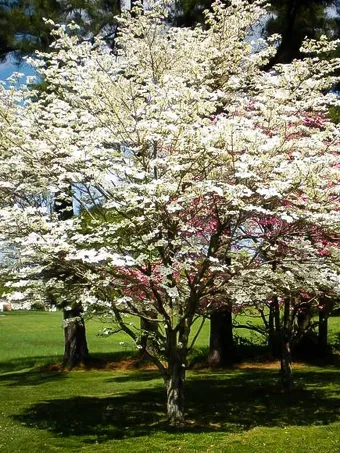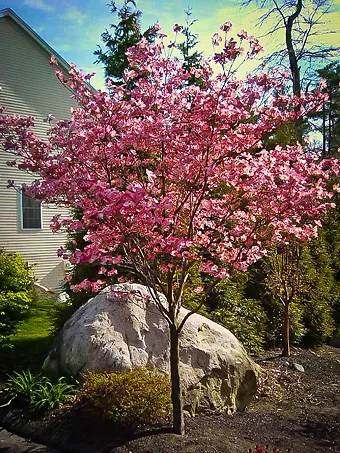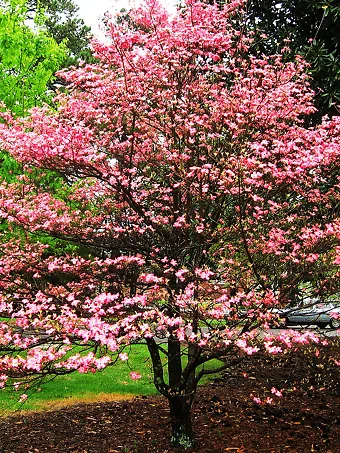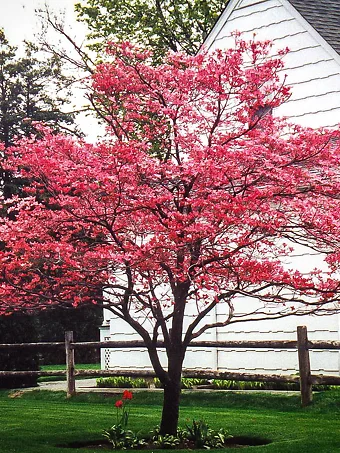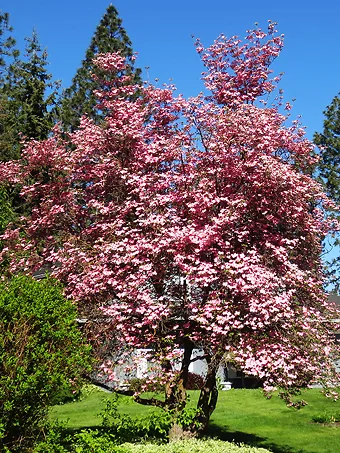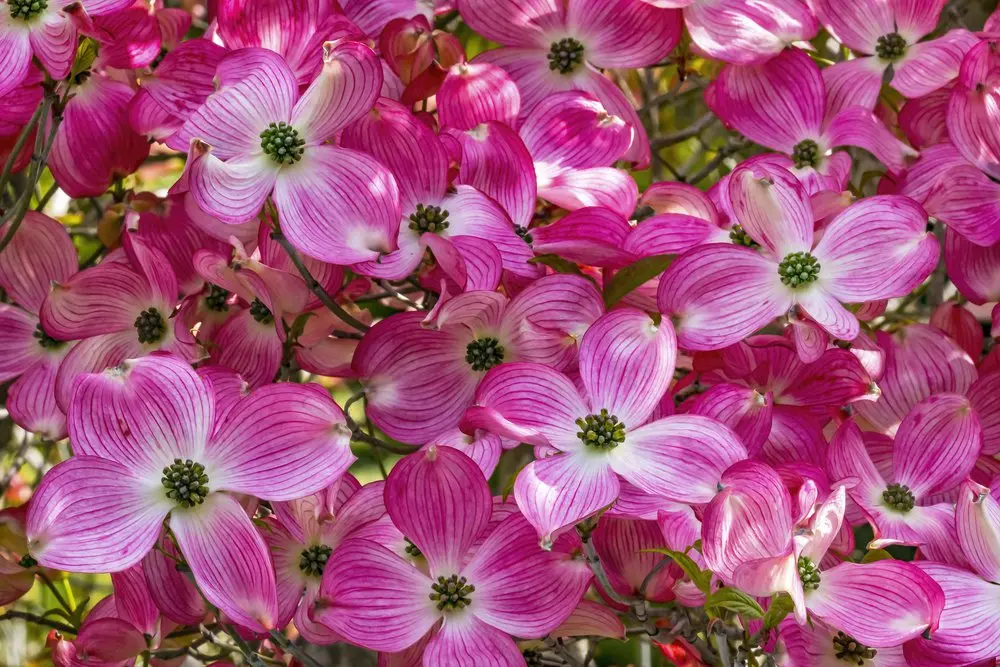
Written by s • The Eternal Charm of the Flowering Dogwood Tree
In the spring garden, two flowering trees stand out – the flowering cherry and the flowering dogwood. Both have their fans, but while for flash, perhaps the cherry wins, nothing can match the charm and beauty of a dogwood tree in full bloom. These trees also win in the other seasons, with much more attractive and reliable foliage, brilliant fall color, and the possibility of berries too. In recent years new forms with colored leaves have added extra dimensions too, so if you are looking for a spring flowering tree, you cannot go wrong planting a flowering dogwood.
The American Dogwood Tree
Planting native trees is not just good for the environment, it is good for your garden too. Native trees almost always grow best in their own land, because they are adapted to the climate and to the broader environment too. Don’t be fooled by this plant being called Cornus florida by botanists – it doesn’t just grow in the south, but all the way up the eastern states into Maine and even in Canada. With such a large natural range it is hardy from zone 5 to 9, happy to grow for you almost anywhere, especially in the east. In southern areas it will be happy in partial shade, and full sun suits it best in the north. Clay soils are not a problem, and deer normally leave it alone.
In its wild state this tree grows 15 to 30 feet tall, and much of its beauty is in the way the branches spread horizontally, forming a broad pyramid that really shows off the stunning display of flowers. Unlike some other spring trees, these don’t appear on bare branches, but develop shortly after the leaves come out in spring. Actually, we might say ‘flowers’, but what we admire on the dogwood tree are not the flowers, which are small and greenish, but the large modified leaves, called bracts. These are what we see as petals, an effect also seen in that perennial Christmas favorite, the Poinsettia. In wild trees these bracts are white, so a tree in bloom resembles a late snow-fall, with branches so densely covered in blooms the leaves are almost completely obscured.
The natural color for the Flowering Dogwood is white, or rather the palest ivory. But for the garden that is only the beginning. If you are planting in a semi-natural setting, perhaps along the margins of a wooded area, white is a great choice, and it always glows out of shady spots, lifting and brightening the view. For garden settings, though, there are many brighter choices, and every shade of pink exists, from very pale to near-red. The garden beauty of this tree doesn’t end with the flowers. Red berries decorate the tree in late summer, although these are often quickly taken by hungry birds. Don’t copy them, as the berries are bitter. Then in fall the leaves turn rich shades of red, ending another season of beauty from these wonderful trees.
One of the very best of the pink-flowering trees, and a real classic, is the variety called ‘Cherokee Chief’. Not only are the spring flowers a gorgeous deep pink, but the leaves too are red in spring and summer, making a real statement in any garden. Its discovery by Isaac J. Hawkersmith in Tennessee in the 1950s created a whole industry in his neighborhood of Franklin county, which became a center for dogwood production, supplying much of the country. Others in this series include the white ‘Cherokee Princess’, and the pink ‘Cherokee Brave’, and all of them are healthy, strong, and vigorous plants that are better garden choices than wild forms.
The Asian Dogwood Tree
By one of those quirks of nature, we find a very similar tree to the American dogwood growing half-way round the world, in Japan and China. This tree, Cornus kousa, and its Chinese form, Cornus kousa var chinensis, are very similar to their American cousins, and hard for an ordinary gardener to tell apart. They do tend to be smaller and shrubbier in form, but with a little training can easily be grown as a multi-stem tree.
There is one big difference that everyone can see – they flower about a month later, so they extend the Flowering Dogwood season well into early summer. This alone would make them very desirable in the garden, but there is more. In some parts of the country the American dogwood is prone to a lethal disease called anthracnose. This causes branches and then entire limbs to die, quickly killing even larger trees. If you have lost trees from this disease, or if you live in an area where it is common, then the Kousa Dogwood, as the Asian tree is often called, is for you. It is resistant to this disease, making it a top choice anywhere American dogwoods are dying.
Like the American dogwood, you can find the Kousa Dogwood in many colors, from white, through pale pinks, and in dark pinks too. By growing both trees – the American and the Asian – you can have dogwoods in flower in your garden from mid-spring to early summer. Although these trees don’t have much fall color, the red berries are sweet and edible, and some people even make a wine from them.
Hybrid Dogwood Trees
The fact that the Asian dogwood is resistant to anthracnose attracted the attention of plant scientists and breeders, and at Rutgers University they bred the two together, looking to create new trees combining the best qualities of both. They have given us some wonderful trees. Not only are they vigorous and disease resistant, they are faster-growing, and they thrive in a much wider range of garden conditions. There are lots of colors, with pinks and red in profusion. Fall color is often good, and many have the bonus of rich red foliage from spring and through much of the year.
A top choice, and worth looking for, is Little Ruby. As you might guess from the name, this tree is smaller, so it’s ideal for smaller gardens, and tucking into smaller spaces. It only grows about 10 feet tall and wide, and it is often wider than tall, really showing off its blooms. These are a rich pink, arriving later in the season, showing the trees Asian heritage. All the new growth is deep red, and in fall the purple-red leaves make a spectacular finale to the garden year. In warmer areas those fall leaves stay on the tree through to spring, making this effectively an evergreen tree and a great winter feature.
If your garden is large enough for a larger tree, then choose the Stellar Pink dogwood, another Rutgers hybrid that will reach 20 feet tall and wide. It has the same spectacular purple-red fall colors of Little Ruby, and the flowers are a wonderful light and bright pink. Like all these hybrids it is of course disease resistant.
In Conclusion. . .
With all these choices there is a Flowering Dogwood for every garden and every situation. For spectacular displays they can’t be beaten, so make this the year you plant one, and enjoy their unique and eternal charm and beauty.
